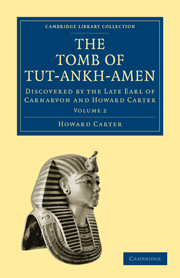Book contents
- Frontmatter
- PREFACE
- Contents
- LIST OF PLATES
- INTRODUCTION. REMARKS UPON EGYPTIAN ART
- CHAPTER 1 TUT-ANKH-AMEN
- CHAPTER 2 THE TOMB AND BURIAL CHAMBER
- CHAPTER 3 CLEARING THE BURIAL CHAMBER AND OPENING THE SARCOPHAGUS
- CHAPTER 4 THE STATE CHARIOTS
- CHAPTER 5 THE OPENING OF THE THREE COFFINS (SEASON 1925–26)
- CHAPTER 6 POINTS OF INTEREST IN EGYPTIAN BURIAL CUSTOMS
- CHAPTER 7 THE EXAMINATION OF THE ROYAL MUMMY
- APPENDICES
- INDEX
- Plate section
- Plate section
CHAPTER 6 - POINTS OF INTEREST IN EGYPTIAN BURIAL CUSTOMS
Published online by Cambridge University Press: 05 March 2012
- Frontmatter
- PREFACE
- Contents
- LIST OF PLATES
- INTRODUCTION. REMARKS UPON EGYPTIAN ART
- CHAPTER 1 TUT-ANKH-AMEN
- CHAPTER 2 THE TOMB AND BURIAL CHAMBER
- CHAPTER 3 CLEARING THE BURIAL CHAMBER AND OPENING THE SARCOPHAGUS
- CHAPTER 4 THE STATE CHARIOTS
- CHAPTER 5 THE OPENING OF THE THREE COFFINS (SEASON 1925–26)
- CHAPTER 6 POINTS OF INTEREST IN EGYPTIAN BURIAL CUSTOMS
- CHAPTER 7 THE EXAMINATION OF THE ROYAL MUMMY
- APPENDICES
- INDEX
- Plate section
- Plate section
Summary
Undoubtedly the greatest ceremony which awaited every Egyptian, in due proportion to his rank, was his funeral.
With the ancient Egyptian in all stations of life, from the Pharaoh to the peasant, there was a profound yearning for a good burial. To secure this wish he made, in accordance with his rank, elaborate preparations and it was naturally his desire that his survivors would see that they were carried out. The general attitude of mind of the ancient Egyptians towards the benefits of a good burial is expressed, with simple dignity, in the story of a certain Sinuhe which has come down to us from the Middle Kingdom, some forty centuries ago, and is translated by Dr. Alan Gardiner:
Remember then the day of burial, the passing into beatitude; when the night shall be devoted to thee with oils and with bandages, the handiwork of Tayt [i.e. the goddess of weaving]. There is a procession to be made for thee on the day thou art reunited with the earth: thy mummy-case of gold, with head of lapis lazuli, a heaven [i.e. shrine] above thee—the while that thou art placed upon the hearse, and oxen drag thee. Then shall musicians await thy coming, and the dance of the Muu be performed at the door of thy tomb. The words of offering shall be pronounced on thy behalf, and victims slaughtered at the door of thy stele.
- Type
- Chapter
- Information
- The Tomb of Tut-Ankh-AmenDiscovered by the Late Earl of Carnarvon and Howard Carter, pp. 92 - 105Publisher: Cambridge University PressPrint publication year: 2010First published in: 1927



